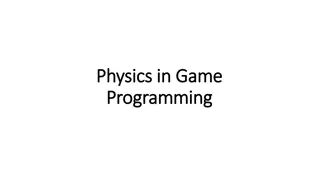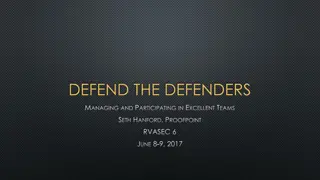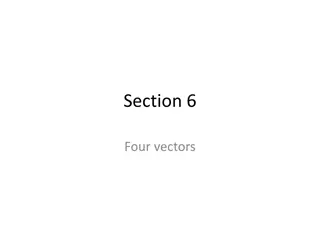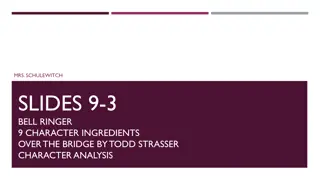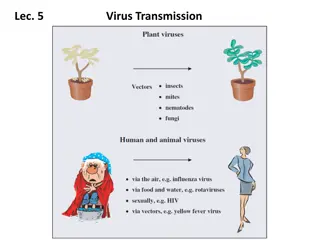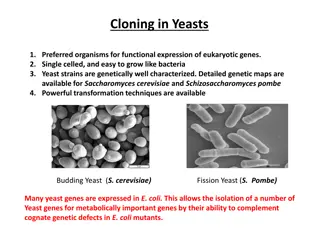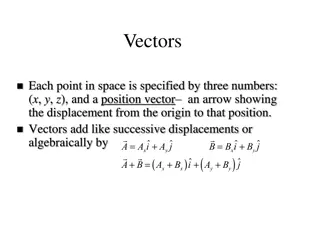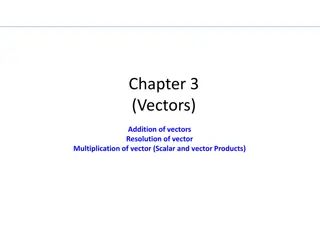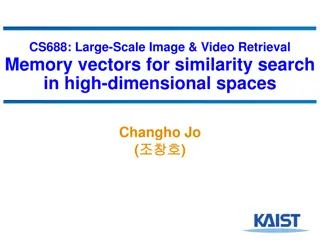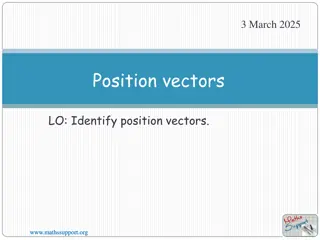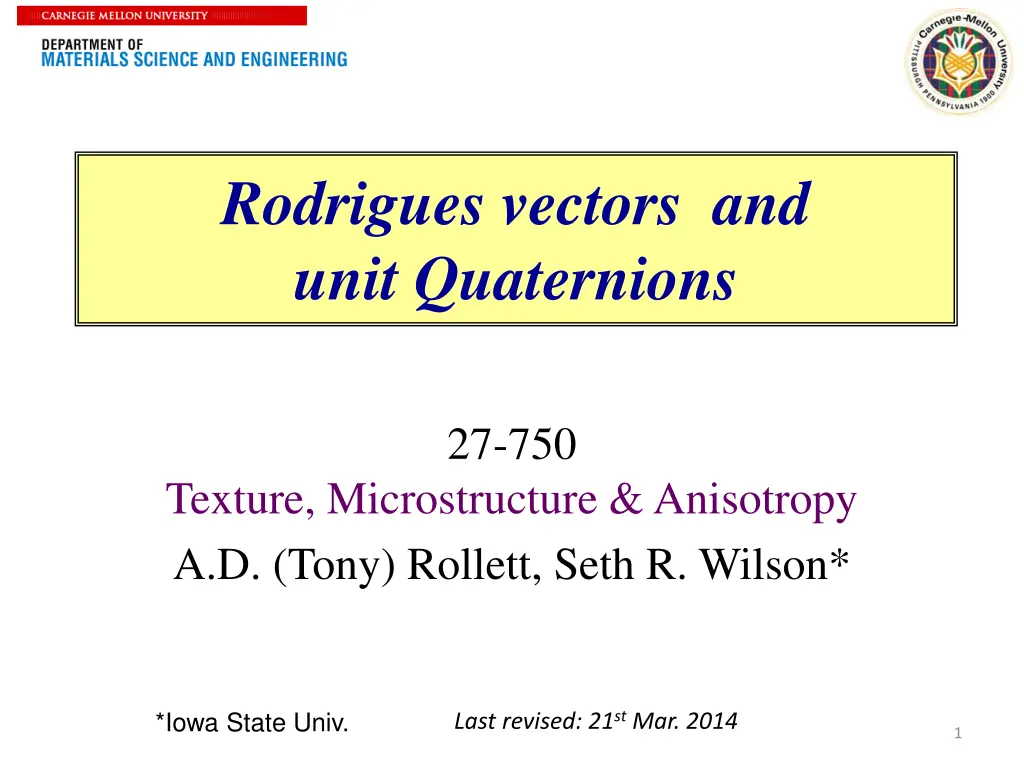
Understanding Rodrigues Vectors and Unit Quaternions
Discover the significance of rotations and orientations, and delve into concepts such as Rodrigues-Frank vectors and quaternions as rotation operators. Learn about conversions between Euler angles, rotation matrices, RF vectors, and quaternions for efficient manipulation of orientations.
Download Presentation

Please find below an Image/Link to download the presentation.
The content on the website is provided AS IS for your information and personal use only. It may not be sold, licensed, or shared on other websites without obtaining consent from the author. If you encounter any issues during the download, it is possible that the publisher has removed the file from their server.
You are allowed to download the files provided on this website for personal or commercial use, subject to the condition that they are used lawfully. All files are the property of their respective owners.
The content on the website is provided AS IS for your information and personal use only. It may not be sold, licensed, or shared on other websites without obtaining consent from the author.
E N D
Presentation Transcript
Rodrigues vectors and unit Quaternions 27-750 Texture, Microstructure & Anisotropy A.D. (Tony) Rollett, Seth R. Wilson* *Iowa State Univ. Last revised: 21st Mar. 2014 1
Objectives Briefly describe rotations/orientations Introduce Rodrigues-Frank vectors Introduce quaternions Learn how to manipulate and use quaternions as rotation operators Discuss conversions between Euler angles, rotation matrices, RF vectors, and (unit) quaternions
Why do we need to learn about orientations and rotations? gB gA gS Orientation distributions: Define single-grain orientations relative sample reference frame, and take symmetry into account (both sample and crystal).
Why do we need to learn about orientations and rotations? gAB = gBgA 1 gB gA gS Misorientation distributions: Compare orientations on either side of grain boundaries to determine boundary character. MISORIENTATION : The rotation required to transform from the coordinate system of grain A to grain B
Review: Euler angles Euler angles: ANY rotation can be written as the composition of at most 3 very simple rotations. R( 1, , 2) = R( 2)R( )R( 1) Once the Euler angles are known, rotation matrices for any rotation are therefore straight- forward to compute. z-x-z rotation sequence Movie credit: Wikipedia
Review: Euler angles Difficulties with Euler angles: Non-intuitive, difficult to visualize. There are 12 different possible axis-angle sequences. The standard sequence varies from field to field, and even within fields. Every rotation sequence contains at least one artificial singularity, where Euler angles do not make sense, and which can lead to numerical instability in nearby regions. Operations involving rotation matricies derived from Euler angles are not nearly as efficient as quaternions. z-x-z rotation sequence Movie credit: Wikipedia
Passive rotations We want to be able to quantify transformations between coordinate systems Passive rotations: Given the coordinates (vx,vy,vz) of vector v in the black coordinate system, what are its coordinates (vx,vy,vz) in the red system? Unit sphere
Active rotations We want to be able to quantify transformations between coordinate systems Active rotations: Given the coordinates (vx,vy,vz) of vector v in the black coordinate system, what are the coordinates (wx,wy,wz) of the rotated vector w in the black system? Unit sphere Passive / Active : only a minus sign difference, but it is very important
Basics, reviewed We also need to describe how to quantify and represent the rotation that relates any two orientations An orientation may be represented by the rotation required to transform from a specified reference orientation (sample axes) Unit sphere We need to be able to quantitatively represent and manipulate 3D rotations in order to deal with orientations
How to relate two orthonormal bases? First pick a direction represented by a unit normal r Two numbers related to the black system are needed to determine r Unit sphere (i.e. rx and ry, or latitude and longitude, or azimuthal and polar angles)
How to relate two orthonormal bases? To specify an orthonormal basis, one more number is needed (such as an angle in the plane perpendicular to r) Three numbers are required to describe a transformation from the black basis to the red basis Unit sphere . . .the right hand rule and orthogonality determine the position of third basis vector.
Rodrigues vectors Any rotation may therefore be characterized by an axis r and a rotation angle about this axis R(r, ) axis-angle representation The RF representation instead scales r by the tangent of /2 ( ) r = rtan a /2 BEWARE: Rodrigues vectors do NOT obey the parallelogram rule (because rotations are NOT commutative!) See slide 16 Note semi-angle
Rodrigues vectors Rodrigues vectors were popularized by Frank [ Orientation mapping. Metall. Trans.19A: 403-408 (1988)], hence the term Rodrigues-Frank space for the set of vectors. Most useful for representation of misorientations, i.e. grain boundary character; also useful for orientations (texture components). Application to misorientations is popular because the Rodrigues vector is so closely linked to the rotation axis, which is meaningful for the crystallography of grain boundaries. 13
Cubic crystal symmetry; no sample symmetry Miller Index Map in RF- space The map shows the location of texture components, identified as (hkl)[uvw], up to order 2. Note that many of the low index points lie on the boundary of the cubic- triclinic fundamental zone. If the component has a name, or belongs to a fiber, that is noted next to the point. Generated by RFpoints_HKLUVW_1Jun07.f 14
Transformation Matrix from Axis-Angle Pair Written out as a complete 3x3 matrix: ( ) gij=dijcosq + rirj1-cosq + eijkrksinq k=1,3 cosq + u21-cosq ( uv 1-cosq ( uw 1-cosq ( ) uv 1-cosq ( cosq +v21-cosq vw 1-cosq ( )+ wsinq uw 1-cosq ( vw 1-cosq ( cosq + w21-cosq )-vsinq )+ usinq )-wsinq )+vsinq ( ) = )-usinq ( ) Note the + sign before the third term (with permutation tensor), signifying a passive rotation. 15
Axis-Angle from Matrix The rotation axis, r, is obtained from the skew-symmetric part of the matrix: (a23-a32),(a31-a13),(a12-a21) (a23-a32)2+(a31-a13)2+(a12-a21)2 r = Another useful relation gives us the magnitude of the rotation, , in terms of the trace of the matrix,aii: aii=3cos +(1 cos )ni 2=1+2cos , therefore, cos = 0.5 (trace(a) 1). See the slides on Rotation_matrices for what to do when you have small angles, or if you want to use the full range of 0-360 and deal with switching the sign of the rotation axis. Also, be careful that the argument to arc-cosine is in the range -1 to +1 : round-off in the computer can result in a value outside this range. 16
Symmetry Operator examples Diad on z: [uvw] = [001], = 180 - substitute the values of uvw and angle into the formula cos180+021-cos180 ( 0*0 1-cos180 ( 0*11-cos180 ( ) 0*0 1-cos180 ( cos180+021-cos180 0*11-cos180 ( )+1*sin180 0*11-cos180 ) )-0sin180 ( ( )-0sin180 )+0sin180 -1 0 0 0 -1 0 0 0 )-wsin180 )+0sin180 ( gij= 0*11-cos180 cos180+121-cos180 = ( ) 1 4-fold on x: [uvw] = [100] = 90 ( ) 1*0 1-cos90 ( cos90+021-cos90 0*0 1-cos90 ( )+ wsin90 0*11-cos90 ) )-1sin90 ( ( )-0sin90 )+1sin90 cos90+121-cos90 0*11-cos90 ( 0*11-cos90 ( 1 0 0 -1 0 0 0 0 1 )-0sin90 )+0sin90 ( gij= 1*0 1-cos90 cos90+021-cos90 = ( ) 17
Matrix representation of the rotation point groups - What is a group? A group is a set of objects that form a closed set: if you combine any two of them together, the result is simply a different member of that same group of objects. Rotations in a given point group form closed sets - try it for yourself! Note: the 3rd matrix in the 1st column (x-diad) is missing a - on the 33 element; this is corrected in this slide. Also, in the 2nd from the bottom, last column: the 33 element should be +1, not -1. In some versions of the book, in the last matrix (bottom right corner) the 33 element is incorrectly given as - 1; here the +1 is correct. Kocks, Tom , Wenk: Ch. 1 Table II The 4 operators enclosed in orange boxes are also the 222 point group, appropriate to orthorhombic symmetry 18
Cubic Crystal Symmetry Operators The numerical values of these symmetry operators can be found at: http://neon.materials.cmu.edu/texture_subroutines: quat.cubic.symm etc. 19
(432) in unit quaternions quat.symm.cubic file with 24 proper rotations in quaternion form 24 0 0 0 1 1 0 0 0 0 1 0 0 0 0 1 0 0.707107 0 0 0.707107 0 0.707107 0 0.707107 0 0 0.707107 0.707107 -0.707107 0 0 0.707107 0 -0.707107 0 0.707107 0 0 -0.707107 0.707107 0.707107 0.707107 0 0 -0.707107 0.707107 0 0 0 0.707107 0.707107 0 0 -0.707107 0.707107 0 0.707107 0 0.707107 0 -0.707107 0 0.707107 0 0.5 0.5 0.5 0.5 -0.5 -0.5 -0.5 0.5 0.5 -0.5 0.5 0.5 -0.5 0.5 -0.5 0.5 -0.5 0.5 0.5 0.5 0.5 -0.5 -0.5 0.5 -0.5 -0.5 0.5 0.5 0.5 0.5 -0.5 0.5 Cubic point group; proper rotations expressed as quaternions; the first four lines/elements/operators are equivalent to (222) and represent orthorhombic symmetry; the next 12 lines are 90 rotations about <100> or 180 rotations about <110>; the last 8 lines are 120 rotations. 20
21 Conversions: matrix RF vector Conversion from rotation (misorientation) matrix, due to Morawiec, with gAB=gBgA-1: 1 2 3 [ g(1,2) g(2,1)]/ 1+ tr( g) [ g(2,3) g(3,2)]/ 1+ tr( g) [ g(3,1) g(1,3)]/ 1+ tr( g) =
22 Conversion from Bunge Euler Angles tan( ) = ( cos( ) cos ( 1 + ) 1 = tan( /2) [cos{( 1- 2)/2}/cos{( 1 + 2)/2}] 2 = tan( /2) [sin{( 1- 2)/2}/[cos{( 1 + 2)/2}] 3 = tan{( 1 + 2)/2} P. Neumann (1991). Representation of orientations of symmetrical objects by Rodrigues vectors. Textures and Microstructures 14-18: 53-58. Conversion from Rodrigues to Bunge Euler angles: sum = atan(R3) ; diff = atan ( R2/R1 ) 1 = sum + diff; = 2. * atan(R2 * cos(sum) / sin(diff) ); 2 = sum - diff
23 Conversion Rodrigues vector to axis transformation matrix Due to Morawiec: Example for the 12 entry: NB Morawiec s Eq on p22 has a minus sign in front of the last term; this will give an active rotation matrix, rather than the passive rotation matrix seen here.
24 Combining Rotations as RF vectors Two Rodrigues vectors combine to form a third, C, as follows, where B follows after A. Note that this is not the parallelogram law for vectors! C = ( A, B) = { A + B - A x B}/{1 - A B} addition vector product scalar product
Combining Rotations as RF vectors: component form 25 [ [ [ ], ], ] ) r1 A+r1 B- r2 Ar3 B-r3 Ar2 B r2 A+r2 B- r3 Ar1 B-r1 Ar3 B r3 1- r1 A+r3 ( B- r1 Ar2 B-r2 Ar1 B r1 ( )= C,r2 C,r3 C Ar1 B+r2 Ar2 B+r3 Ar3 B
Quaternions: Yet another representation of rotations What is a quaternion? A quaternion is first of all an ordered set of four real numbers q0, q1, q2, and q3, (sometimes q1, q2q3, and q4) . Here, i, j, k are the familiar unit vectors that correspond to the x-, y-, and z-axes, resp. Addition of two quaternions and multiplication of a quaternion by a real number are as would be expected of normal four-component vectors. Vector part Scalar part Conjugate of a quaternion: Magnitude of a quaternion: On a New Species of Imaginary Quantities Connected with a Theory of Quaternions, by William Rowan Hamilton, Proceedings of the Royal Irish Academy, 2 (1844), 424 434.
Multiplication of two quaternions However, quaternion multiplication is ingeniously defined in such a way so as to reproduce rotation composition. Multiplication of the basis quaternions is defined as follows: [1] Quaternion multiplication is non-commutative (pq qp). [2] There are similarities to complex numbers (which correspond to rotations in 2D). From these rules it can be shown that the product of two arbitrary quaternions p,q is given by: Using more compact notation: Vector part Scalar part On a New Species of Imaginary Quantities Connected with a Theory of Quaternions, by William Rowan Hamilton, Proceedings of the Royal Irish Academy, 2 (1844), 424 434.
Unit quaternions as rotations We state without proof that a rotation of degrees about the (normalized) axis r may be represented by the following unit quaternion: It is easy to see that this is a unit quaternion, i.e. that Note the similarity to Rodrigues vectors, except with a different scaling. For two rotations q and p that share a single axis r, note what happens when q and p are multiplied:
Multiplication of a quaternion and a 3-D vector It is useful to define the multiplication of vectors and quaternions as well. Vectors have three components, and quaternions have four. How to proceed? Every vector vcorresponds to a pure quaternion whose 0th component is zero. and proceed as with two quaternions: Note that in general that the product of a quaternion and a vector can result in a non-pure quaternion with non-zero scalar component.
Rotation of a vector by a unit quaternion Although the quantity qv may not be a vector, it can be shown that the triple products q*vqand qvq* are. In fact, these vectors are the images of v by passive and active rotations corresponding to quaternion q. Passive rotation Active rotation
Rotation of a vector by a unit quaternion Expanding these expressions yields Passive rotation Active rotation Moreover, the composition of two rotations (one rotation following another) is equivalent to quaternion multiplication. since
Example: Rotation of a Vector by Quaternion-Vector Multiplication Consider rotating the vector i by an angle of = 2 /3 about the <111> direction. Rotation axis: k j For an active rotation: i For a passive rotation:
Positive vs Negative Rotations One curious feature of quaternions that is not obvious from the definition is that they allow positive and negative rotations to be distinguished. This is more commonly described in terms of requiring a rotation of 4 to retrieve the same quaternion as you started out with but for visualization, it is more helpful to think in terms of a difference in the sign of rotation. 33
Positive vs Negative Rotations Let s start with considering a positive rotation of about an arbitrary axis, r. From the point of view of the result one obtains the same thing if one rotates backwards by the complementary angle, - 2 (also about r). Expressed in terms of quaternions, however, the representation is different! Setting r = [u,v,w] again, q(r, ) = q(u sin /2, v sin /2, w sin /2, cos /2) - 2 34
Positive vs Negative Rotations q(r, ) = q(usin( )/2, v sin( )/2, w sin( )/2, cos( )/2) = q(-usin /2, -v sin /2, -w sin /2, -cos /2)= -q(r, ) - 2 35
Positive vs Negative Rotations The result, then is that the quaternion representing the negative rotation is the negative of the original (positive) rotation. This has some significance for treating dynamic problems and rotation: angular momentum, for example, depends on the sense of rotation. For static rotations, however, the positive and negative quaternions are equivalent or, more to the point, physically indistinguishable, q -q. Caution! By negative rotation we mean the position arrived at by rotating in the opposite direction. This is not the same as taking the same axis but rotating in the opposite sense. 36
37 Conversions: matrix quaternion Formulae, due to Morawiec: ( ) 1+ tr g 2 cos 2=121+ tr g ( ) q4= ijk gjk 4 1+ tr g Note: passive rotation/ axis transformation (axis changes sign for for active rotation) qi= ( ) ( ) ( ) ( ) [ g(2,3) g(3,2)]/2 1+ tr g [ g(3,1) g(1,3)]/2 1+ tr g [ g(1,2) g(2,1)]/2 1+ tr g 1+ tr g Note the coordination of choice of sign! q1 q2 q3 q4 = ( )/2
38 Bunge angles quaternion [q1, q2, q3, q4] = [sin /2 cos{( 1 - 2)/2 }, sin /2 sin{( 1 - 2)/2}, cos /2 sin{ 1 + 2)/2}, cos /2 cos{( 1 + 2)/2} ] Note the occurrence of sums and differences of the 1st and 3rd Euler angles (that eliminate the degeneracy at the origin of Euler space)!
39 References Frank, F.C. (1988). Orientation mapping, Metallurgical Transactions 19A: 403-408. P. Neumann (1991). Representation of orientations of symmetrical objects by Rodrigues vectors. Textures and Microstructures 14-18: 53-58. Takahashi Y, Miyazawa K, Mori M, Ishida Y. (1986). Quaternion representation of the orientation relationship and its application to grain boundary problems. JIMIS-4, pp. 345-52. Minakami, Japan: Trans. Japan Inst. Metals. (1st reference to quaternions to describe grain boundaries). A. Sutton and R. Balluffi (1996), Interfaces in Crystalline Materials, Oxford. V. Randle & O. Engler (2000). Texture Analysis: Macrotexture, Microtexture & Orientation Mapping. Amsterdam, Holland, Gordon & Breach. S. Altmann (2005 - reissue by Dover), Rotations, Quaternions and Double Groups, Oxford. A. Morawiec (2003), Orientations and Rotations, Springer (Europe). William Rowan Hamilton (1844), On a New Species of Imaginary Quantities Connected with a Theory of Quaternions , Proceedings of the Royal Irish Academy, 2: 424 434. M. Olinde Rodrigues (1840), Des lois g om triques qui r gissent les d placements d un syst me solide dans l espace et de la variation des coordonn es provenant de ces d placements consid r es ind pendamment des causes qui peuvent les produire , Journal des Math matiques Pures et Appliqu es, 5: 380-440.



